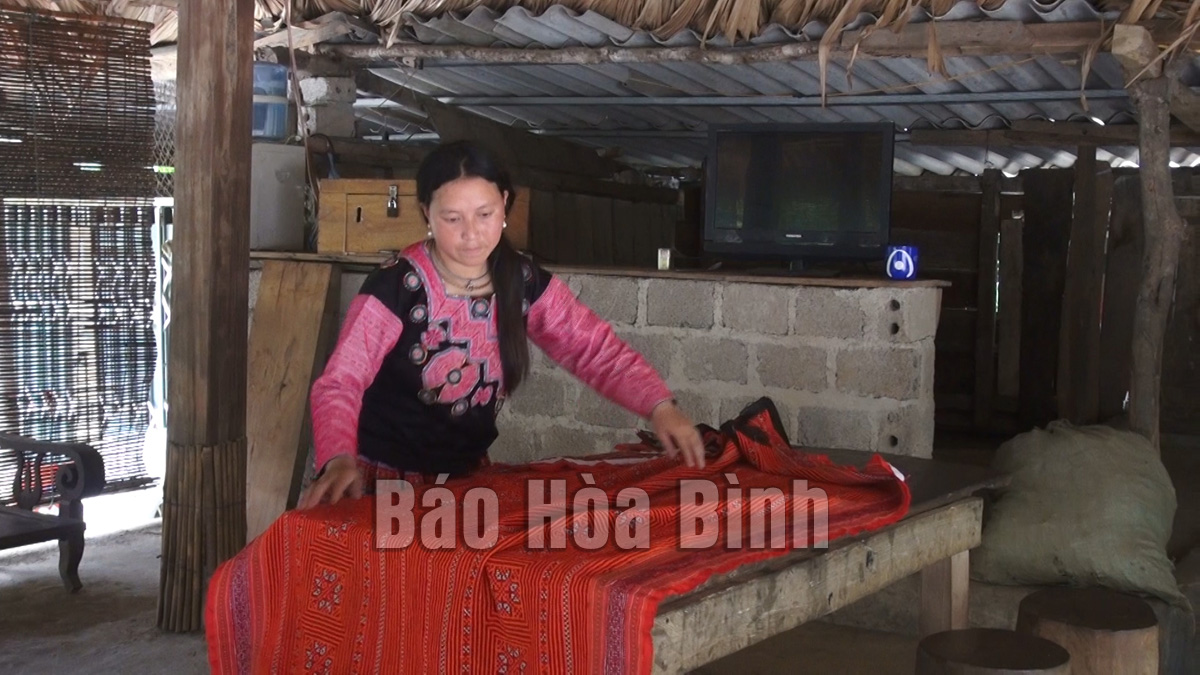



The traditional costumes of the Mong people.
The traditional costumes of the Mong people are made with many unique hand-crafted and pattern-forming techniques. These practices, passed down over the generations include embroidery, weaving, fabric stitching, metal grafting, and beeswax drawing. The richness in skill not only reflects the value of the costumes, but also the creativity, craft work and aesthetic abilities of the Mong ethnic people.
Although the costumes of the Mong ethnic group in Mai Chau district have similarities in sewing techniques, skirt and shirt styles with other Mong branches, there are still differences, bearing their own imprints.
Mong women wear long-sleeved black blouses. The front lap is short to the waist, the back lap is slightly longer. The sleeves are added with green or red cloth. The skirt is indigo dyed with floral patterns with colorful thread embroidered into the material. The decorations on the clothes are mainly made up of colored cloth mosaics and the embroidery patterns are mainly in the shapes of squares, fillings and cross. They typically wear a lot of silver neck bracelets, blue and red beaded waistband and many silver coins and silver bells tied together. Men's clothing is often black, extending the sleeves with cloth added red and blue thread. They wear a wide tube with a blue waistband tied in the front and it is dropped down.
In step with development, the material and spiritual life of the people of Hang Kia and Pa Co communes has gradually changed. Cultural exchanges have been expanded, and tourism has developed. However, the value of traditional culture and the costumes of the Mong people are gradually disappearing. Instead of using self-woven linen, the Mong people choose to save time and buy fabrics with readymade printed and embroidered patterns to make their costumes. There are less artisans who retain the folk knowledge and techniques necessary to create traditional costumes.
According to Luu Huy Linh, Deputy Director of the Department of Culture, Sports and Tourism, in recent years, towards cultural development common goal stated in the 8th Central Committee’s Resolution 5, the Department has advised the provincial People's Committee to pay attention and focus on preserving, promoting and exploiting the cultural values of ethnic minorities, including the cultural heritage of the Mong ethnic group. It is important to promoted the socio-economic development programmes in two communes of Hang Kia and Pa Co, to preserve the cultural values and orientation of tourism development.
In order to better implement the conservation, promotion and exploitation of the cultural heritage of the Mong ethnic people, in the coming time, the culture sector in the province will strengthen coordination at all levels, and develop human resources dedicated to the conservation of cultural heritage, and honoring excellent artisans.
In addition, it will enhance the introduction and promotion of the beauty, cultural values and history of traditional costumes of the Mong ethnic group to all classes of people.
It will also develop solutions to planning and developing the raw material areas for flax plants, conduct research and restore ancient patterns and preserve pattern making techniques.
In particular, the culture sector will implement a synchronous solution of conservation activities associated with tourism development, turning the costumes of the Mong people into a unique and attractive tourism product that attracts tourists, and contributes to the development of the socio-economy./.